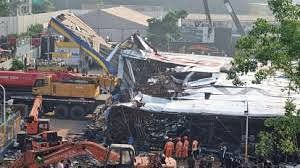The Hindu Editorial Analysis- 20th May 2024 | Current Affairs & Hindu Analysis: Daily, Weekly & Monthly - UPSC PDF Download

A Minor Girl Victim Support Scheme that Loses its Way
Why in News?
O n November 30, 2023, the Ministry of Women and Child Development notified the “Scheme for Care and Support to Victims under Section 4 & 6 of the Protection of Children from Sexual Offences (POCSO) Act, 2012”. The objective is to provide integrated support and assistance to minor pregnant girl child victims “under one roof” and facilitate immediate emergency and non-emergency access to services for long-term rehabilitation. For reasons best known to the Ministry though, the name of the scheme does not reflect the intents.
What is the POCSO Act 2012?
The Protection of Children from Sexual Offences (POCSO) Act, enacted on November 14, 2012, addresses the critical issue of sexual offences against children by outlining both punishments for offenders and support systems for victims. Key sections include:
Section 4: Punishment for Penetrative Sexual Assault
- Individuals found guilty of penetrative sexual assault face imprisonment for a minimum of ten years, which can be extended to life imprisonment. Additionally, they are liable to pay a fine.
- If the victim is under sixteen years old, the offender faces a minimum imprisonment of twenty years, which can extend to life imprisonment, meaning imprisonment for the remainder of their natural life, along with a fine.
- The fine imposed must be fair and reasonable, and it is to be paid to the victim to cover medical expenses and rehabilitation costs.
Section 6: Punishment for Aggravated Penetrative Sexual Assault
- Those convicted of aggravated penetrative sexual assault are subject to rigorous imprisonment for at least twenty years, which can extend to life imprisonment, implying imprisonment for the remainder of the offender's natural life, or they may face the death penalty. They are also liable to pay a fine.
- Similar to Section 4, the fine must be just and reasonable, intended to support the victim's medical expenses and rehabilitation needs.
A Towering Hazard, the Height of Poor Enforcement

Why in News?
At least 16 people were killed when a massive 250-tonne advertisement hoarding (on Government Railway Police land) in Mumbai's Ghatkopar collapsed during a dust storm.
- In the wake of this tragedy, it is important to examine the safety regulations pertaining to hoardings and who is legally responsible for the event.
What Safety Norms Apply to Hoardings?
Local bodies are responsible for issuing licenses for advertisement hoardings. In Mumbai, this process is governed by several regulations and guidelines:
Mumbai Municipal Corporation (MMC) Act, 1888 (amended): According to this act, written permission from the Municipal Commissioner is required to erect advertisement hoardings.
Policy Guidelines for Display of Advertisements, 2018:
- These guidelines mandate that a registered structural engineer must certify the structural stability of hoardings before they are erected.
- Hoardings existing as of May 1, 2014, must be reinstalled to meet the structural stability requirements.
Bureau of Indian Standards (BIS):
- The BIS provides technical specifications for calculating wind loads on hoardings.
- It includes formulae for determining the force coefficients applicable to structures exposed to wind.
These regulations ensure that advertisement hoardings in Mumbai are safely constructed and maintained.
What Led to Ghatkopar Incident?
- The massive hoarding did not meet size norms: But was not brought down by official agencies in spite of being a highly visible hazardous structure.
- Safety norms were apparently liberalised:
- This was done through the Policy Guidelines for Display of Advertisements 2018 to tap the city’s full financial potential.
- Also, the MMC Act 1888 provides some regulatory exemptions to hoardings on railway land.
- Administrative lethargy: The Government Railway Police cited an ongoing dispute with the Corporation for not enforcing the safety laws on hoardings.
- No database of permits available: For example, no database of permits could be located on the BMC website in the hoardings section.
- Extreme weather events: The Ghatkopar disaster demonstrates that extreme weather, such as high winds or a cyclone sweeping a city, quickly exposes the weakest infrastructure links, with deadly consequences.
Who is Legally Responsible for the Ghatkopar Incident?
- The government and the owners of the private structures are legally responsible for the incident.
- The right of passage on a public pathway makes several connected individuals liable for negligence in the Ghatkopar case, including
- The owners of the land,
- The agency that put up the structure and the line officials responsible for enforcement,
- The civic officials and police who witnessed flagrant violation of rules but took no action, etc.
- In 2022, the Delhi HC, after fixing the liability of a public sector bank (BoB), granted compensation in a case where a man was struck by a sign board and the head injury led to his death.
What Needs to be Done to Avoid Ghatkopar like Incidents?
- Governments must diligently protect citizens from potential harm caused by official actions. Strengthening administrative capabilities and tackling corruption are critical priorities. The emergence of digital boards, which offer dynamic displays and the ability for multiple advertisers to share the same screen, has significantly increased revenue for hoarding companies.
- However, it's imperative to enhance disaster management practices in municipalities, especially in crowded urban areas. For example, in a recent Mumbai incident, the proximity of a petrol pump hindered the use of gas cutters, compromising disaster response effectiveness.
- Given the growing challenges posed by climate change, city governments need to reassess the traditional practice of installing large outdoor hoardings near populated areas. This reevaluation is necessary to ensure safety and adapt to evolving environmental conditions.
|
39 videos|4263 docs|897 tests
|
FAQs on The Hindu Editorial Analysis- 20th May 2024 - Current Affairs & Hindu Analysis: Daily, Weekly & Monthly - UPSC
| 1. What is the Minor Girl Victim Support Scheme and what is its purpose? |  |
| 2. How has the Minor Girl Victim Support Scheme lost its way according to the article? |  |
| 3. What are some of the challenges faced by the Minor Girl Victim Support Scheme? |  |
| 4. How can the Minor Girl Victim Support Scheme be improved to better serve its purpose? |  |
| 5. What are the consequences of the Minor Girl Victim Support Scheme failing to provide adequate support to minor girl victims? |  |
|
39 videos|4263 docs|897 tests
|

|
Explore Courses for UPSC exam
|

|
















